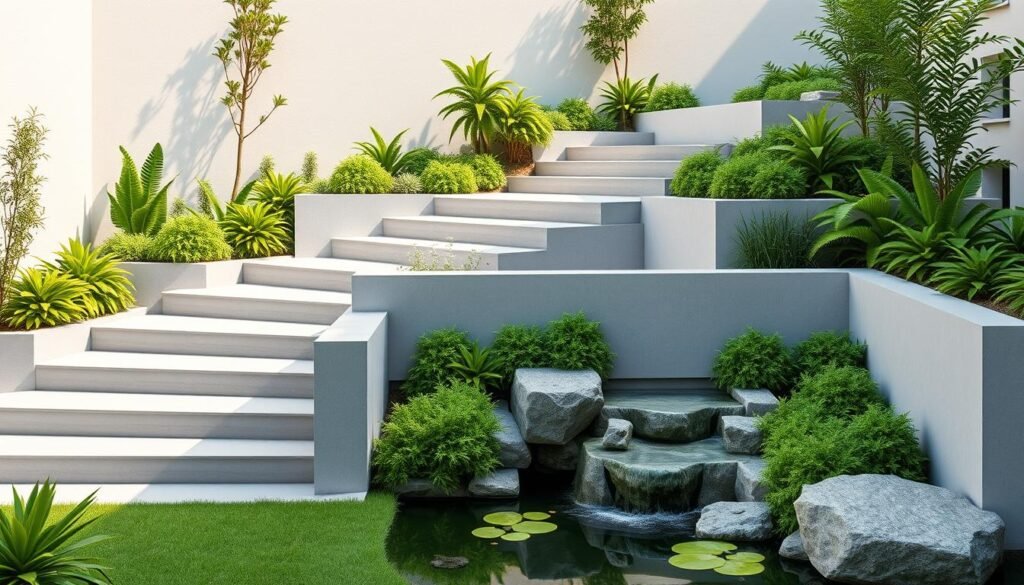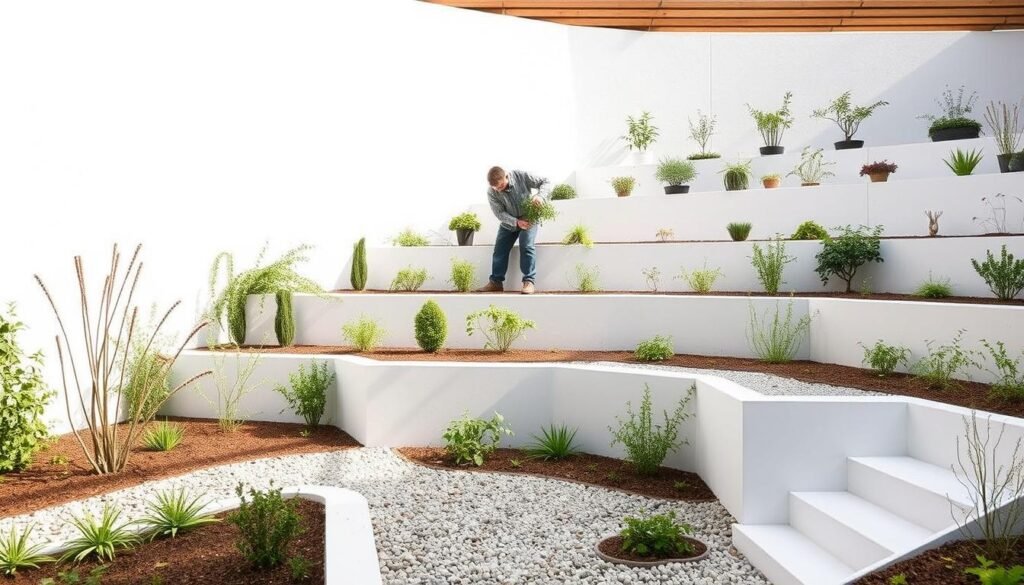Did you know vertical gardening can boost your garden’s space by up to 30%? A minimalist garden with a tiered layout does more than just save space. It turns your outdoor area into a peaceful, easy-to-care-for spot, like a zen garden. By layering plants and materials smartly, even tiny yards can become green, welcoming spaces.
In this guide, we’ll show you how to make your own minimalist tiered garden. We’ll cover the basics of gardening minimalism and picking the right plants. Get ready to make your outdoor space more beautiful and useful with a simple, yet effective garden design.
Understanding the Basics of Minimalist Gardening
Minimalist gardening is all about simplicity and beauty. It focuses on clean lines, simple colors, and the right plants. This approach makes your outdoor space calm and easy to care for.
Defining Minimalism in Garden Design
Minimalism in garden design is simple:
- Simplicity: Minimalist gardens have clean lines and simple shapes. They use a few colors to create a peaceful feel.
- Functionality: Every part of a minimalist garden has a purpose. It might be a place to sit, a water feature, or a special plant.
- Negative Space: Empty space is just as important as the filled areas. It lets the eye rest and enjoy the garden’s design.
Benefits of a Minimalist Approach
Choosing minimalism in gardening has many advantages:
| Benefit | Description |
|---|---|
| Reduced Maintenance | Minimalist gardens need less care. They have fewer plants and more stone or gravel, making them perfect for those who are busy. |
| Increased Focus | With fewer plants, each one gets more attention. This highlights their beauty and the garden’s design. |
| Sense of Tranquility | Minimalist gardens are calm and peaceful. They offer a quiet break from the hustle and bustle of everyday life. |
Learning about minimalism can help you create a beautiful, low-maintenance garden. It shows how simplicity can be stunning in gardening.
Planning Your Tiered Garden Layout
Starting a minimalist tiered garden needs careful planning and design. Assess your garden space, sketch your layout, and pick the right materials. This will turn your outdoor area into a peaceful and beautiful spot. Let’s explore the key steps for planning your tiered garden layout.
Assessing Your Garden Space
First, evaluate your garden. Think about sunlight, soil, and any features like trees or slopes. Know your space’s size and shape to decide on your garden’s scale. Note any challenges or opportunities in your site to guide your design.

Sketching Your Design
With a good understanding of your space, start sketching your garden. Use a pencil to draw out your vision. Think about tier placement and paths, seating, and focal points. Your sketch doesn’t need to be perfect; it’s a starting point to refine later.
Choosing Materials for Tiers
The materials for your tiers affect your garden’s look and durability. Popular choices include:
- Natural stone: Gives a timeless look but is pricey and hard to install.
- Concrete blocks: Offer a modern look, are easy to install, and affordable.
- Wooden timbers: Add a rustic charm but need upkeep to avoid rot.
- Gabion walls: Have a unique texture with metal wire cages filled with rocks.
When picking materials, think about durability, cost, and style fit. This will help you choose the best for your garden.
| Material | Pros | Cons |
|---|---|---|
| Natural Stone | Timeless, organic look | Expensive, labor-intensive |
| Concrete Blocks | Modern, clean, affordable | Less natural appearance |
| Wooden Timbers | Warm, rustic charm | Requires regular maintenance |
| Gabion Walls | Unique texture, customizable | Can be heavy and complex to install |
By assessing your site, sketching your design, and choosing the right materials, you’ll create a beautiful minimalist tiered garden. It will enhance your outdoor space and bring your vision to life.
Selecting Plants for a Minimalist Tiered Garden
Choosing the right plants is key for a minimalist tiered garden. You want plants that look good and need little care. Ornamental grasses, succulents, and herb gardens are great choices. They make your garden look good and work well together.
Ornamental Grasses for Texture and Movement
Ornamental grasses are perfect for minimalist gardens. They add texture and movement. They come in different heights, colors, and textures, fitting many garden styles.
- Feather Reed Grass (Calamagrostis x acutiflora)
- Blue Oat Grass (Helictotrichon sempervirens)
- Mexican Feather Grass (Nassella tenuissima)
- Fountain Grass (Pennisetum alopecuroides)
Succulents for Low-Maintenance Beauty
Succulents are great for minimalist gardens. They need little water and care but look amazing. They come in many shapes, sizes, and colors, making your garden stand out.
| Succulent | Characteristics |
|---|---|
| Sedum | Low-growing, spreading habit; ideal for ground cover or spilling over edges |
| Echeveria | Rosette-forming; comes in a variety of colors and sizes |
| Agave | Architectural, bold foliage; perfect for creating focal points |
| Aloe | Sculptural, fleshy leaves; adds texture and interest to the garden |
Incorporating Functional Plants like Herbs
Adding herbs to your garden is a smart move. They give you fresh herbs and make your garden smell good. Herbs like rosemary, thyme, oregano, lavender, and sage are great for minimalist gardens.
- Rosemary
- Thyme
- Oregano
- Lavender
- Sage
By picking ornamental grasses, succulents, and herbs, you’ll have a beautiful and easy-to-care-for garden. It will be both beautiful and useful.
Designing Minimalist Garden Tiered Layout
Creating a minimalist tiered garden design needs careful planning. Follow these steps to make a stunning and useful garden. This will make the most of your outdoor space.
First, decide on the number and height of tiers for your garden. Think about the look you want and how easy it will be to maintain. A good design should look deep and clean, without being cluttered.

Then, focus on balancing your design. Place hardscaping and plants in a way that looks good. Use the same plants or materials in different places to create harmony. This will help your garden look simple and elegant.
Choose a few types of plants that look good together. Make sure they have enough room to grow. Group plants that need the same care to make your garden easier to look after.
Add focal points to catch the eye and add interest. These can be special plants, sculptures, or even a small water feature. But don’t overdo it to keep the design simple.
| Element | Purpose | Example |
|---|---|---|
| Tiers | Create depth and dimension | Varying heights and widths |
| Hardscaping | Provide structure and balance | Stone retaining walls, gravel paths |
| Plant Placement | Establish visual harmony | Repetition of species, grouping by care needs |
| Focal Points | Draw the eye and create interest | Architectural plants, sculptures, water features |
Finally, think about the hardscaping in your garden. Choose materials that match your home and the area around it. Use simple shapes and clean lines to keep the look minimalist. Make sure functional parts, like stairs, fit well with the design.
By thinking about every part of your garden, you can make a beautiful and useful space. Follow the rules of simplicity, balance, and harmony to create a stunning garden.
Maintaining Your Minimalist Tiered Garden
After designing and planting your minimalist tiered garden, keeping it up is crucial. Simple watering, fertilizing, and pruning can keep your garden healthy and free of clutter for years.

Watering and Fertilizing Techniques
Watering your garden efficiently is key. Think about using a drip irrigation system. It sends water straight to the roots, saving water and reducing waste. For fertilizing, choose organic slow-release fertilizers. They give nutrients steadily without harming your plants.
Pruning and Shaping Plants
Pruning is vital for keeping your plants in shape. It stops them from getting too big and keeps your garden looking neat. Use sharp tools to cut off dead or damaged parts. Pruning also helps your plants grow better and bloom more.
| Plant Type | Pruning Frequency | Pruning Tips |
|---|---|---|
| Ornamental Grasses | Annually | Cut back to a few inches above the ground in late winter or early spring before new growth emerges. |
| Succulents | As needed | Remove dead or damaged leaves and stems to maintain a clean appearance and prevent rot. |
| Herbs | Regularly | Pinch back stems to encourage bushier growth and prevent flowering for a longer harvest. |
Keeping Your Garden Clutter-Free
To keep your garden looking minimalist, remove dead leaves, weeds, and debris. This keeps your garden clean and prevents diseases and pests. Don’t add too many decorations. They can take away from your garden’s simple beauty.
By following these tips and staying consistent, your minimalist tiered garden will stay beautiful and healthy for many seasons.
Conclusion
Creating a minimalist tiered garden is a way to make a peaceful and easy-to-care-for outdoor space. It’s about keeping things simple yet functional. This lets you turn your garden into a calm and beautiful place.
Starting with your garden’s layout and choosing the right plants is rewarding. Ornamental grasses add texture and movement. Succulents are beautiful and easy to care for. Adding herbs makes your garden look good and serves a purpose.
When you start your minimalist garden, remember that simplicity is key. This approach helps you create a space that’s perfect for relaxing. Use these ideas to make your garden a peaceful retreat from the world.



